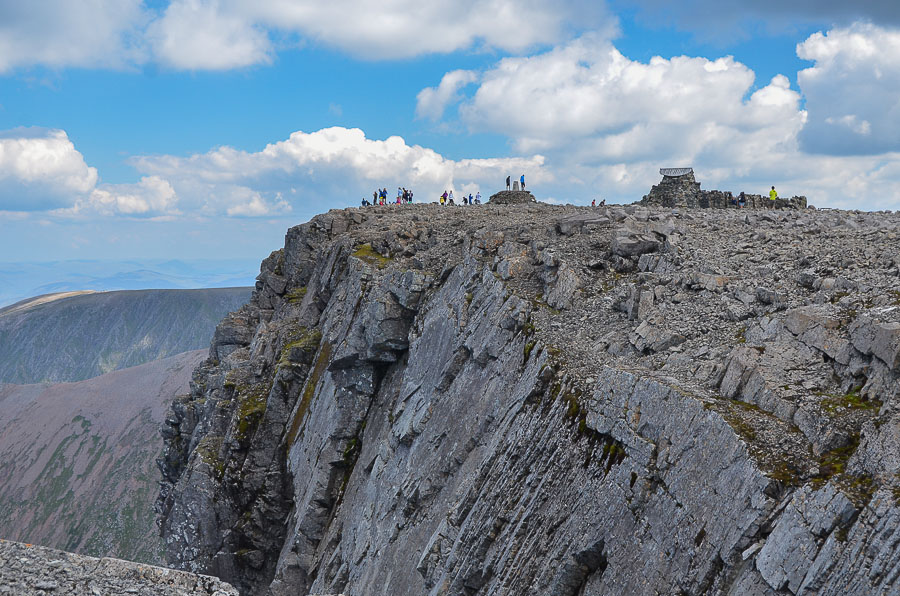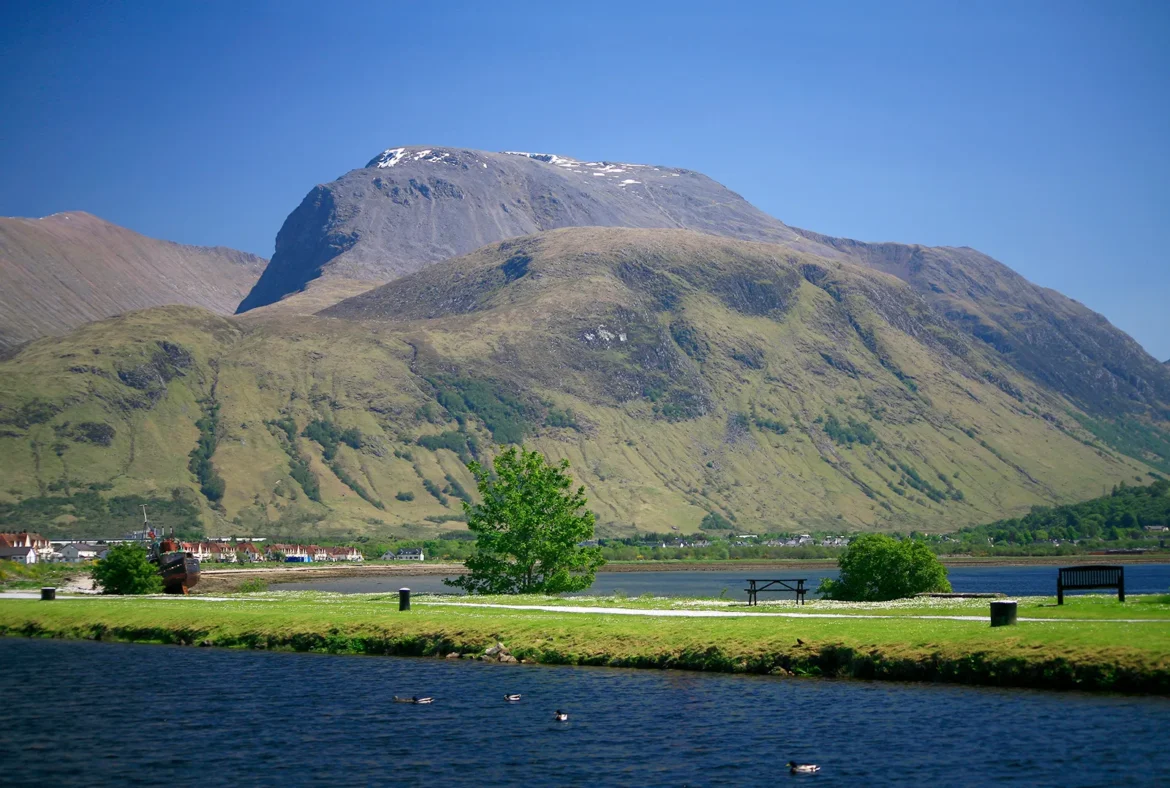Ben Nevis, towering above the town of Fort William in the Scottish Highlands, is the highest mountain in the British Isles, standing proudly at 1,345 metres (4,413 feet). Known in Gaelic as Beinn Nibheis, which is often translated as “Venomous Mountain” or “Mountain with its Head in the Clouds,” Ben Nevis is both a geographical landmark and a symbol of endurance and adventure. Its prominence, challenging weather conditions, and rugged beauty make it one of the most celebrated and visited natural features in Scotland, attracting climbers, walkers, and nature enthusiasts from all over the world.

Geography and Location
Ben Nevis lies at the western end of the Grampian Mountain range, within the Lochaber area of the Highlands. Its location above Fort William makes it highly accessible, and its connection to Loch Linnhe and the surrounding glens adds to its dramatic setting. The mountain forms part of a wider massif, with neighbouring peaks such as Carn Mòr Dearg, Aonach Mòr, and Aonach Beag offering equally impressive ridges and routes. The summit plateau is expansive and often windswept, with steep cliffs on its north face plunging dramatically into Coire Leis, making it a striking sight for mountaineers.
Geological History
The origins of Ben Nevis go back around 350 million years, when violent volcanic activity shaped much of the Highland landscape. The mountain itself is the collapsed dome of an ancient volcano, with evidence of this dramatic history still visible in its rocky formations. Granite dominates the summit, while basalt and other igneous rocks can be found lower down, bearing witness to the turbulent geological forces that forged the Highlands. For geologists, Ben Nevis provides a unique record of volcanic and glacial activity, as its slopes also display marks left by ice during the last Ice Age.
Climate and Conditions
Despite its popularity, Ben Nevis is known for its harsh and unpredictable weather. Due to its height and northern latitude, conditions at the summit can be very different from those in Fort William below. On average, the summit is shrouded in cloud for over 300 days of the year, with strong winds, rain, and even snow possible in every season. Temperatures are typically several degrees colder than at sea level, and snow can linger on the upper slopes well into late spring or even early summer. These conditions make preparation essential for anyone attempting to climb the mountain.
The Summit
At the top of Ben Nevis lies a broad, stony plateau, marked by a cairn and a trig point that signify the highest point in the British Isles. Nearby are the ruins of an observatory, which operated from 1883 until 1904, providing meteorological data that proved invaluable for understanding Highland weather patterns. The remains of the building still stand, offering a glimpse into the challenging life of those who once lived and worked there year-round. Today, visitors often pause at the summit cairn to take in the views—though clear skies are far from guaranteed, on a fine day the panorama stretches across the Highlands, out to the Isle of Skye, and even as far as Northern Ireland.
Routes to the Top
There are two main routes to the summit, catering to different levels of experience and ambition.
- The Mountain Track (Pony Track or Tourist Path):
This is the most commonly used route, beginning near Glen Nevis Visitor Centre or Achintee in Fort William. Although the path is long—around 17 km (10.5 miles) return with a climb of over 1,300 metres—it is well maintained and suitable for walkers with a reasonable level of fitness. The trail zigzags up the western flank of the mountain, steadily gaining height until it reaches the summit plateau. - The Carn Mòr Dearg Arête:
For experienced mountaineers, this is one of the most thrilling ways to approach Ben Nevis. The route involves an ascent of Carn Mòr Dearg followed by a dramatic ridge walk along the arête, a narrow, rocky ridge offering stunning views of Ben Nevis’s imposing north face. This route requires good scrambling skills, surefootedness, and careful navigation, especially in poor weather.
Beyond these, climbers also tackle the mountain via its north face cliffs, home to some of the most challenging ice climbing and rock climbing routes in the UK.
Climbing and Mountaineering Heritage
Ben Nevis is a cornerstone of Scottish mountaineering history. Its north face is the largest mountain cliff in the UK, featuring gullies, buttresses, and ridges that have challenged generations of climbers. In winter, the face transforms into a world-class ice climbing arena, drawing mountaineers from across the globe. Routes such as Tower Ridge, Observatory Ridge, and Point Five Gully are renowned classics, demanding skill, experience, and resilience.
The first recorded ascent was made in 1771 by James Robertson, an Edinburgh botanist, who climbed it for scientific study. Since then, countless ascents have been made for exploration, recreation, and challenge. Today, thousands of people summit Ben Nevis each year, whether as a personal achievement, part of charity fundraising events, or in pursuit of outdoor adventure.
Flora and Fauna
Despite its rugged terrain, Ben Nevis supports a surprising variety of plant and animal life. On the lower slopes, birch woods, heather, and mosses thrive, while alpine species adapted to colder climates appear higher up. The mountain is home to rare arctic-alpine plants such as moss campion and alpine lady’s mantle, which cling to the rocky ground near the summit. Wildlife includes red deer, ptarmigan, golden eagles, and mountain hares, making the area rich in natural interest for ecologists and nature enthusiasts alike.
Cultural Significance
Ben Nevis is more than just a physical landmark—it holds cultural and symbolic value for Scotland and beyond. Its Gaelic name reflects the awe with which it was regarded in the past, and it features in literature, folklore, and popular imagination. For many, climbing Ben Nevis is a rite of passage, a bucket-list achievement that connects people to Scotland’s wild landscapes. The mountain also plays a role in the Three Peaks Challenge, where participants climb the highest mountains in Scotland, England, and Wales—Ben Nevis, Scafell Pike, and Snowdon—within 24 hours.
Tourism and Economy
As one of the most visited natural sites in Scotland, Ben Nevis contributes significantly to the economy of Fort William and the wider Highland region. Outdoor tourism, including walking, climbing, mountain biking, and skiing (at nearby Nevis Range), brings visitors year-round. Facilities such as the Glen Nevis Visitor Centre, guided tours, accommodation, and equipment hire all support the local community. While this popularity is beneficial economically, it also raises concerns about environmental impact, with erosion of footpaths and litter being ongoing challenges that require active management.
Challenges and Conservation
Managing Ben Nevis for both conservation and recreation is a delicate balance. Organizations such as the John Muir Trust, which owns and cares for much of the mountain, work to protect its fragile ecosystems while ensuring access for visitors. Projects include maintaining footpaths, restoring habitats, and promoting responsible outdoor behaviour. Climbers and walkers are encouraged to follow the “Leave No Trace” principles, helping to preserve the mountain for future generations.
Conclusion
Ben Nevis stands as a powerful emblem of Scotland’s wild beauty and enduring spirit. Rising above Fort William with its volcanic origins, unpredictable weather, and challenging routes, it commands respect from all who approach it. Whether admired from below, walked via the Mountain Track, or conquered along the thrilling Carn Mòr Dearg Arête, the mountain offers an unforgettable experience. For geologists, climbers, historians, and nature lovers alike, Ben Nevis is more than just the highest point in the British Isles—it is a symbol of challenge, inspiration, and the raw majesty of the Scottish Highlands.

